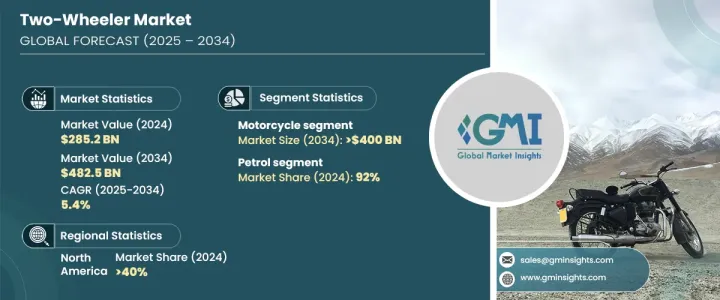
세계의 이륜차 시장은 2024년 2,852억 달러에 이르렀고, 2025년부터 2034년까지 연평균 복합 성장률(CAGR) 5.4%를 나타낼 것으로 예측됩니다.
세계적으로 전기자동차 제조업체가 증가하고 있는 것이 이 성장을 가속하는 큰 요인이 되고 있습니다.

신규 참가 기업은 친환경 모터사이클을 투입하여 시장 역학을 재구성하고 있습니다. 퍼스널 모빌리티에 혁명을 가져오고, 소형·경량의 전기 모터와 대용량 배터리의 통합은 효율을 향상시키고 있습니다.
| 시장 규모 | |
|---|---|
| 시작 연도 | 2024년 |
| 예측 연도 | 2025-2034년 |
| 시작 금액 | 2,852억 달러 |
| 예측 금액 | 4,825억 달러 |
| CAGR | 5.4% |
시장은 이륜차와 스쿠터로 구분되며, 2024년 시장 점유율은 이륜차가 80% 이상을 차지했습니다. 세계 각국의 정부는 보다 엄격한 정책을 실시해, 진화하는 배기 가스 기준에 준거를 요구하고 있습니다.
가처분 소득 증가, 정부 투자 증가, 신흥 경제국 수요 증가가 시장의 성장을 뒷받침하고 있습니다. 가솔린 오토바이는 현재 전 세계 온실가스 배출량의 약 23%를 차지하지만, 전기 모델은 배기관 배출이 없어 더 깨끗한 환경을 조성합니다. 배터리 기술과 충전 인프라가 진보해, 개발도상국에서는 정부 보조금도 지급되기 때문에 전기 이륜차 수요는 앞으로도 계속 증가할 것으로 보입니다.
소비자의 선호도 변화는 업계의 혁신과 맞춤화를 뒷받침하고 있습니다.
추진력에 관해서는 시장은 가솔린 부문와 전동 부문으로 나뉘어져 있습니다. 이로 인해 가솔린 이륜차는 특히 전기차 인프라가 미발달한 많은 지역에서 선호되는 선택지가 되고 있습니다.
기그 이코노미, 특히 식품 및 식료품 택배 서비스의 확대도 신뢰성과 효율성을 제공하는 가솔린 자전거 수요를 지지하고 있습니다. 이를 강화함으로써 엄격한 배기가스 규제를 준수하면서 연료 효율을 향상시키고 있습니다.
2024년 세계의 이륜차 시장은 북미가 점유율의 40% 이상을 차지했으며, 미국이 압도적인 점유율을 차지했습니다. 연방 정부와 주 정부의 세금 공제를 포함한 보조금과 우대 조치 증가는 소비자의 보급을 뒷받침하고 있습니다.
The Global Two-Wheeler Market reached USD 285.2 billion in 2024 and is projected to grow at a CAGR of 5.4% from 2025 to 2034. The increasing number of electric vehicle manufacturers worldwide is a significant factor driving this growth. As sustainability and environmental concerns gain traction, electric motorcycles are becoming more prevalent, boosting market expansion. Leading manufacturers are making strategic investments to remain competitive in the evolving landscape.

New entrants in the industry are introducing eco-friendly motorcycles, reshaping market dynamics. Advances in battery technology, including higher energy densities, extended range, and faster charging, are contributing to the increased adoption of electric two-wheelers. Technological innovation is revolutionizing personal mobility, with compact and lightweight electric motors integrated with high-capacity batteries improving efficiency. Rising global efforts to reduce carbon emissions are accelerating the shift toward electric vehicles.
| Market Scope | |
|---|---|
| Start Year | 2024 |
| Forecast Year | 2025-2034 |
| Start Value | $285.2 Billion |
| Forecast Value | $482.5 Billion |
| CAGR | 5.4% |
The market is segmented into motorcycles and scooters, with motorcycles holding over 80% of the market share in 2024. This segment is expected to surpass USD 400 billion by 2034. Safety regulations and legal requirements are shaping the industry, compelling manufacturers to enhance safety features. Governments worldwide are implementing stricter policies, requiring compliance with evolving emission standards. Manufacturers are also leveraging powder metallurgy in component production, focusing on sustainability and regulatory compliance.
Rising disposable incomes, increasing government investments, and expanding demand in emerging economies are fueling market growth. A growing awareness of environmental issues is further influencing consumers to transition from gasoline-powered motorcycles to electric alternatives. Gasoline motorcycles currently contribute approximately 23% of global greenhouse gas emissions, whereas electric models eliminate tailpipe emissions, fostering a cleaner environment. As battery technology and charging infrastructure advance, along with government subsidies in developing countries, the demand for electric two-wheelers will continue to rise.
Changing consumer preferences are also driving innovation and customization in the industry. Buyers seek unique, personalized experiences, prompting manufacturers to offer customizable design and performance features. This shift is transforming the market from traditional mass production to personalized solutions.
In terms of propulsion, the market is divided into petrol and electric segments. Petrol-powered motorcycles dominated the market with a 92% share in 2024. The affordability, extensive refueling infrastructure, and long riding range make petrol two-wheelers a preferred choice in many regions, especially where electric vehicle infrastructure is underdeveloped. They remain the most viable transportation option in emerging economies due to cost-effectiveness and lower dependency on frequent charging.
The expanding gig economy, particularly in food and grocery delivery services, is also sustaining demand for petrol motorcycles, as they offer reliability and efficiency. Manufacturers are adopting modern fuel injection systems, refining hybrid technology, and enhancing combustion processes to improve fuel efficiency while complying with tightening emission standards. These advancements ensure that petrol motorcycles remain relevant, even as governments push for cleaner mobility alternatives.
North America led the global two-wheeler market in 2024, accounting for over 40% of the share, with the U.S. as the dominant player. The region is witnessing a rising preference for electric motorcycles, fueled by environmental awareness, supportive government policies, and advancements in battery technology. Increasing subsidies and incentives, including federal and state tax credits, are driving consumer adoption. Expanding charging infrastructure is also making electric motorcycles a more practical alternative, reinforcing the market's transition toward sustainable mobility.